Game Analysis: Splinterlands
Date
26 Jan 2023
Author
midhat
Read Time
12 min read
.png)
Highlights
● Started in mid-2018, Splinterlands is a unique NFT trading card game. Powered by the HIVE blockchain, players can do anything they want with their cards and other in-game assets, including battling for rewards, holding them as collectibles, trading on the peer-to-peer market, combining to level up, or even burning to obtain Dark Energy Crystals, the official in-game cryptocurrency of Splinterlands.
● Splinterlands is free to try, giving players a chance to learn the mechanics and begin collecting cards before purchasing. But to be able to earn rewards and trade on the market, players have to buy the Summoner's Spellbook. Once you have it, a unique HIVE blockchain account is created for the player.
● Each battle is unique. There are two formats of ranked battles: Wild (allows all cards from all editions) and Modern (only allows cards from newer editions).
● The gameplay is simple. After players select a Summoner, they need to choose up to 6 Monsters according to their mana availability. The combat will start after the player finishes placing their respective monsters on the battlefield.
● As TCG, the key component of Splinterlands is its cards. They come with four rarities: Common, Rare, Epic, and Legendary. To date, Splinterlands has released 8 Editions of Cards: Alpha, Beta, Untamed, Essence Orb, ΛZMΛRÉ Dice, Chaos Legion, Riftwatchers, and Rewards Edition Cards.
● PeakMonsters is a third-party Splinterlands explorer, market, and interface that was created in the earliest days of Splinterlands. Peakmonsters allows additional market features such as Bids, Rentals, SPS Dashboard, All Market Activities, Pack Openings, Season Rewards, Combining of Cards, and Market History Page.
● After the game is live for under 2 weeks, 1,000 Starter Packs and 38,394 Booster Packs are sold.
● Within a month and a half after Splinterlands was released, the game reached a million matches in 46 days. That means over 21,000 matches per day, over 900 matches per hour, and over 15 matches per minute.
● In November 2020, Splinterlands launched its Android version which is available in the Google Play Store.
● In June 2021, Splinterlands released Untamed Edition booster packs with a total supply of 1.5million packs. And after 48 hours of availability, the booster pack is sold out.
● Launched in mid-2021, Splinterlands on-site card rentals allow players to rent or lend cards directly through the Splinterlands.com collection interface daily.
● At the time of writing, Splinterlands has 61.4K followers on Twitter, 176.5K members on Discord, 19.8K members on Telegram, and 12K followers on Facebook.
● Splinterlands have a public calendar for Public Events hosted by Splinterlands.
● Splinterlands have a central hub for community networking Hosted by Splinterlands on Inverse every two months. The hub is named DYGYCON and is a metaverse convention organized by Splinterlands that features crypto projects, presentations, giveaways, and blockchain projects.
● Splinterlands has weekly updates about release notes on the whitepaper.
● Splinterlands have its media platform designed to be a wiki that fans can explore and contribute to.
Overview
Splinterlands is a unique digital trading card game that allows players to truly own their cards and other in-game assets. Powered by the HIVE blockchain, each card in Splinterlands is a non-fungible token (NFT) owned by a player. That means that players can do anything they want with their cards, including battling for rewards, holding them as collectibles, trading on the peer-to-peer market, combining to level up, or even burning to obtain Dark Energy Crystals, the official in-game cryptocurrency of Splinterlands.
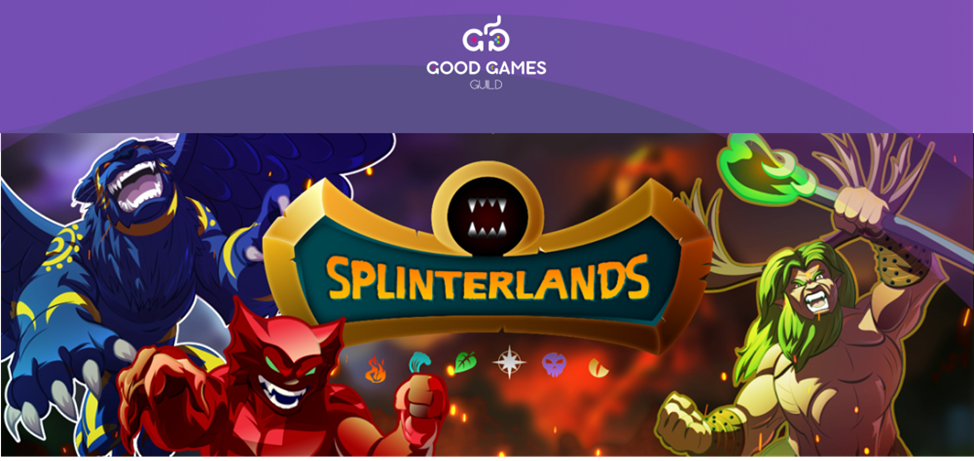
With hundreds of unique cards, Splinterlands is a brilliantly designed and fast-paced trading card game that allows its players to earn by playing. Unlike traditional TCGs, Splinterlands battles are fast, with each match taking only 2-3 minutes. The game is beloved by one of the largest and most loyal followings in the play-to-earn industry. It is translated into nearly a dozen languages and played in over 100 countries worldwide. Each day, thousands of cards are traded for thousands of dollars on the peer 2 peer monster market.
Gameplay
Splinterlands is free to try, giving players a chance to learn the mechanics and begin collecting cards before purchasing the Summoner's Spellbook, but those who are not upgraded miss out on several important features of the game.
• No Rewards can be earned - Players can accept gifts, but they do not earn SPS rewards for battling or rewards for the completion of Daily Focus and Seasons.
• No Tournaments – Only Spellbook-upgraded players have the opportunity to participate in, or create tournaments through the Splinterlands tournament interface.
• No Trading on the Market - Because a player's blockchain account, linked to their new Splinterlands account, is not created until they upgrade by purchasing the Summoner's Spellbook, they are unable to make transactions on the market from a new account, such as buying or selling packs and individual cards. If a user had an existing Hive account, they would still need to purchase a Spellbook to upgrade their account, but they will be able to make transactions on the market.
• No Guilds - Players will not be able to create or join guilds.
Once the Summoner's Spellbook upgrade has been completed, a unique HIVE blockchain account is created for the player and all functions and features of the game are open to them. Purchases of the Summoner's Spellbook include 3000 Credits which can be used in the in-game shop or to purchase or rent cards from the market.
Players must build their collection of cards from the Splinterlands catalog to create teams under different rulesets and battle conditions. There are six sources of magic in the Splinterlands:

Each of these primal forces is championed by distinct factions known as Splinters. A Summoner uses magic to call upon the various races, habitats, and creatures that exist within the same Splinter. For example, a Summoner of the Earth Splinter will be able to call forth monsters that live in the mountains and forests.
To compete with leveled-up card Units, remember that leveled-up Summoners are also needed. For example, to ensure that you have a max playable team from every Element at the Silver League, you must have Summoners that can summon level 5 Commons, level 4 Rares, level 3 Epics, and level 2 Legendaries.
If you have leveled up card Units beyond your summoning capability, they will always be limited in a battle to the maximum level your summoners allow. That's why it's a good idea to level up your Summoners first, then level up the Monster cards to meet their summoning level.

The battle process begins when you select the Battle Format that you would like to participate in on the Battle page, you can choose between the Wild or Modern battle formats.

In the Modern format, newer players don’t need to worry about competing against older cards that may be difficult to acquire due to their scarcity. This will make gameplay fairer for newer players by giving them more of a level playing field. On the other hand, veteran players with a more diverse collection including Alpha & Beta cards may enjoy playing in the Wild format, where all cards from all sets are playable.
Each battle is unique, so once you're matched with an opponent you will see a popup showing you the combat rules for that battle and other information for that battle only.

In this example, there are no changes to the standard combat rules, your team is limited to a total of 25 Mana, and you may only use characters from the Fire, Earth, or Death splinters. Armed with this knowledge, you are now ready to create your team.
Step 1: Summoner
First, you’ll need to select a Summoner and it will fill the left YOUR SUMMONER space. The team building screen will display all the Summoners in your Collection. Your choice of Summoner will determine which Monsters you can use, so choose wisely.
NOTE: The level of your Summoner determines the level of the Monsters that can be added to the team. To see the capabilities of your Summoner, click on the Summoner card from your Collection screen, then select the STATS tab.
Step 2: Monsters
Now that you’ve chosen a Summoner, the Monsters from the Summoner’s splinter will be made available for selection. You may also choose any Neutral monsters, which are monsters that hold no particular allegiance.
You’ve already spent a few Mana when you selected your Summoner. Keep an eye on the Mana counter. It will indicate how close you are to reaching the limit.
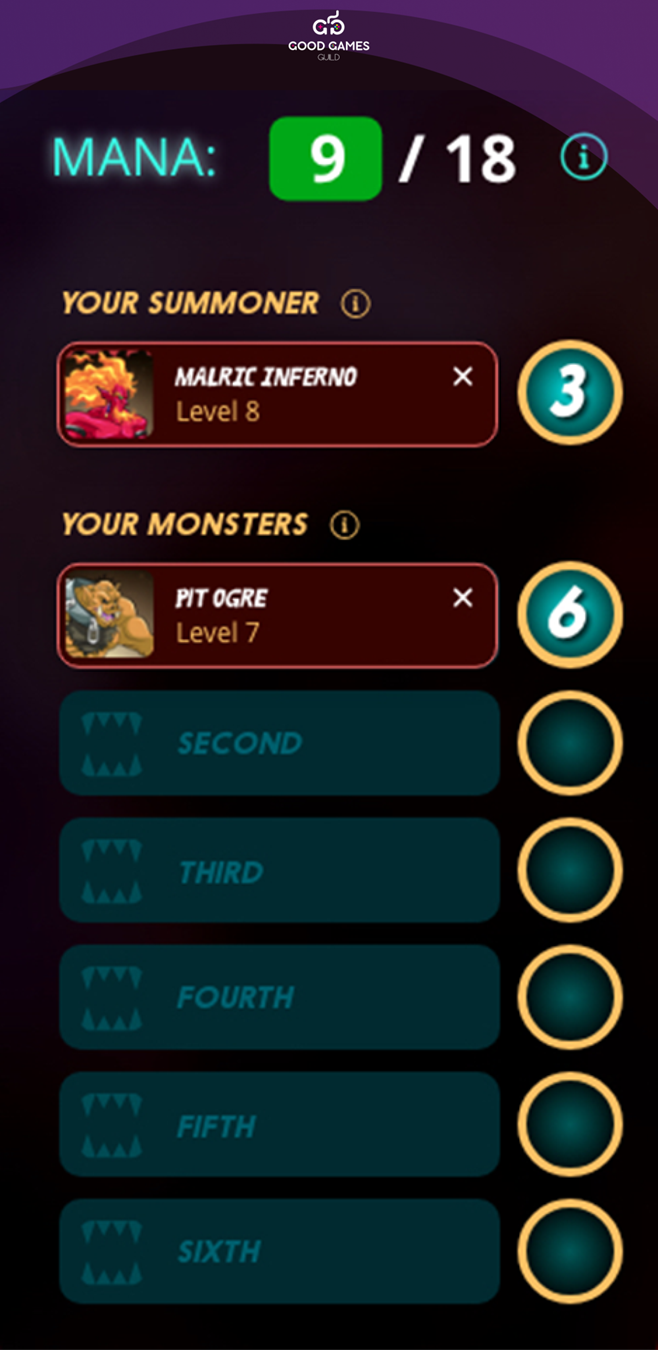
Positioning
To be successful in battle you have to understand the terrain. The battlefield consists of two rows and six positions. The strength of your forces depends on how you can utilize these positions and anticipate your opponent.
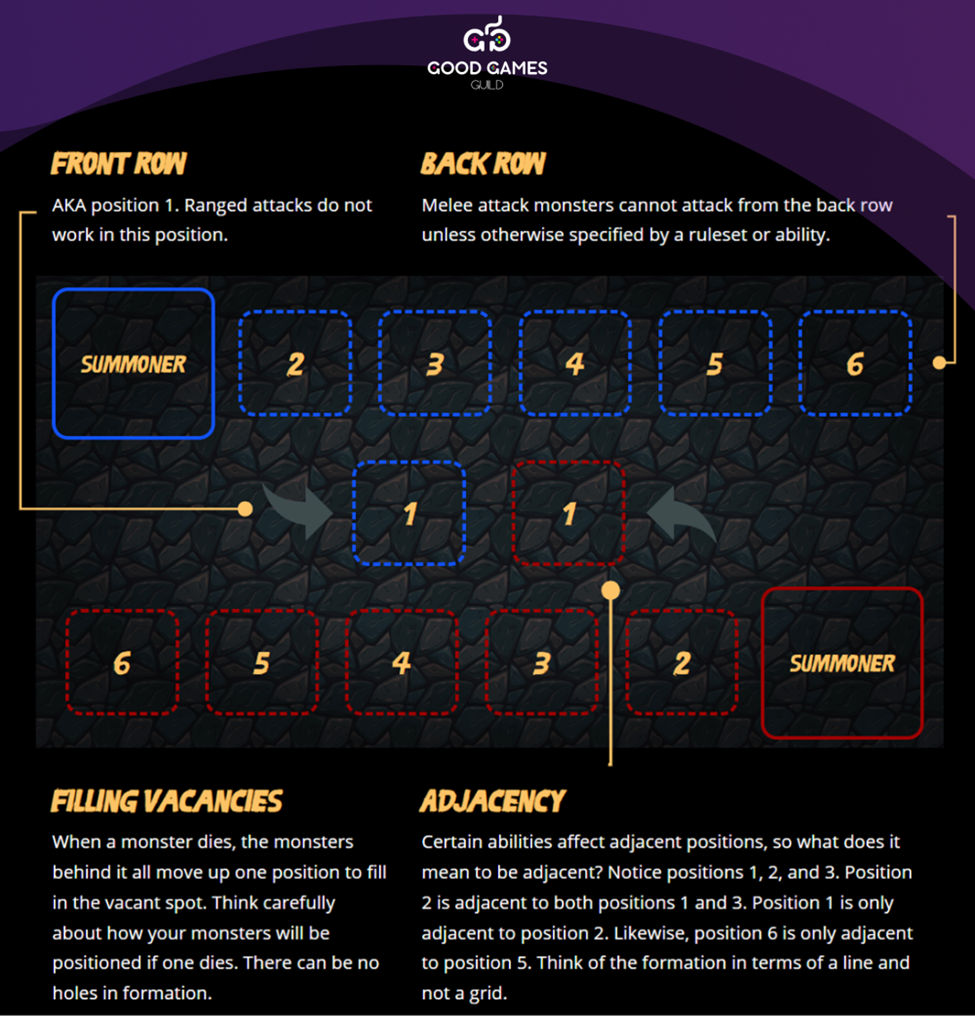
Combat
You have until the timer runs out to select your cards and click BATTLE to submit your team. The Monsters with the highest Speed will take their turns first. If two monsters' speeds are equal, then the attack type is used to break the tie: first magic then ranged, and finally melee. If the attack types are the same, then random order is chosen.
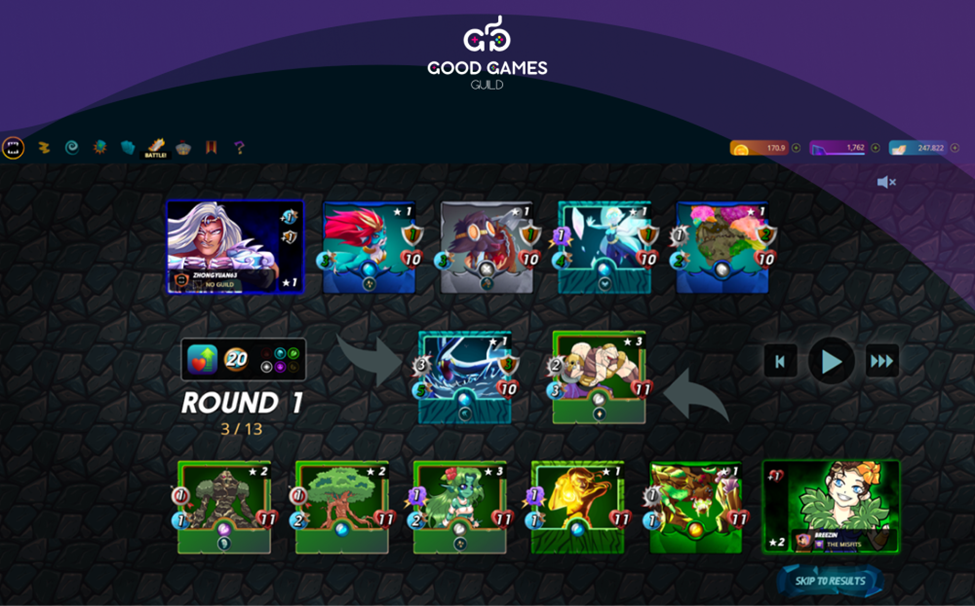
Abilities are what make the fights interesting. Each one makes a unique contribution to the outcome of the battle. They are critical to formulating a winning strategy. The Abilities currently in the game are as follows:

Numerous rewards can be earned in and around Splinterlands.
—Ranked Battle Rewards
The ranked reward system has been put into place to allow each player across all leagues the opportunity to earn increased rewards for daily participation in a sustainable way for battles played with real cards (whether owned or rented).
—Reward Shares (RShares)
RShares (Reward Shares) are earned from Modern and Wild ranked battle wins and will determine the season and daily rewards in addition to Splintershards (SPS) rewards. With all types of ranked battle rewards determined by RShares, it incentivizes achieving higher win rates over simply higher numbers of battles.
—Daily Focus Rewards
Once every 24 hours, players may complete a Daily Focus that is assigned to them at random rotation. A player's Daily Focus will either be based on the use of a specific Element or on using cards with certain abilities.
• Element Based focus requires players to make use of the Element featured for that specific focus.
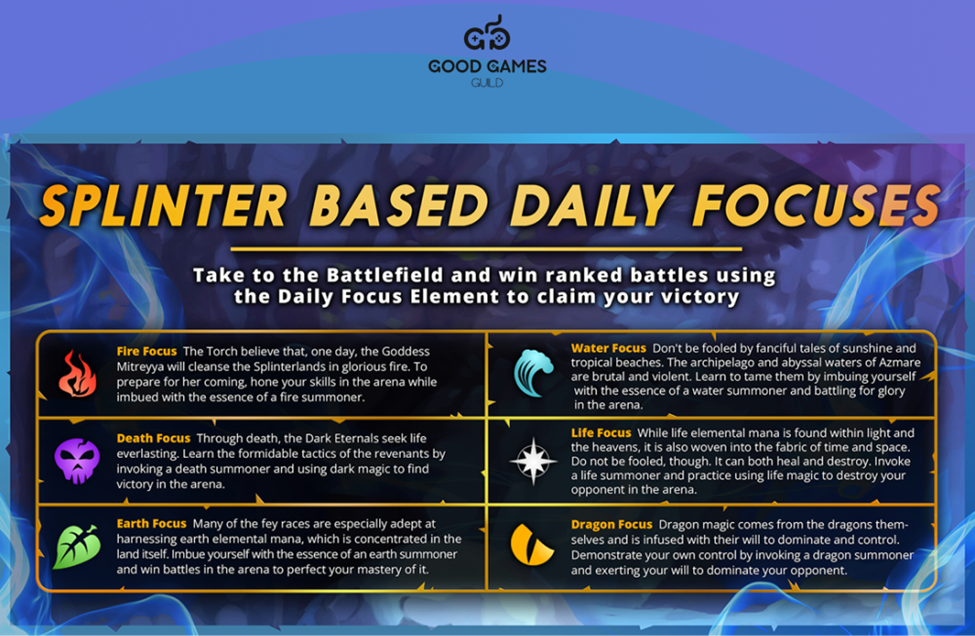
• Ability-Based focus: Each of the various Ability-Based Daily Focuses concentrates on a few different abilities with a common theme. For example, a focus is based on playing at least one card that has either the Sneak, Snipe, or Opportunity ability.
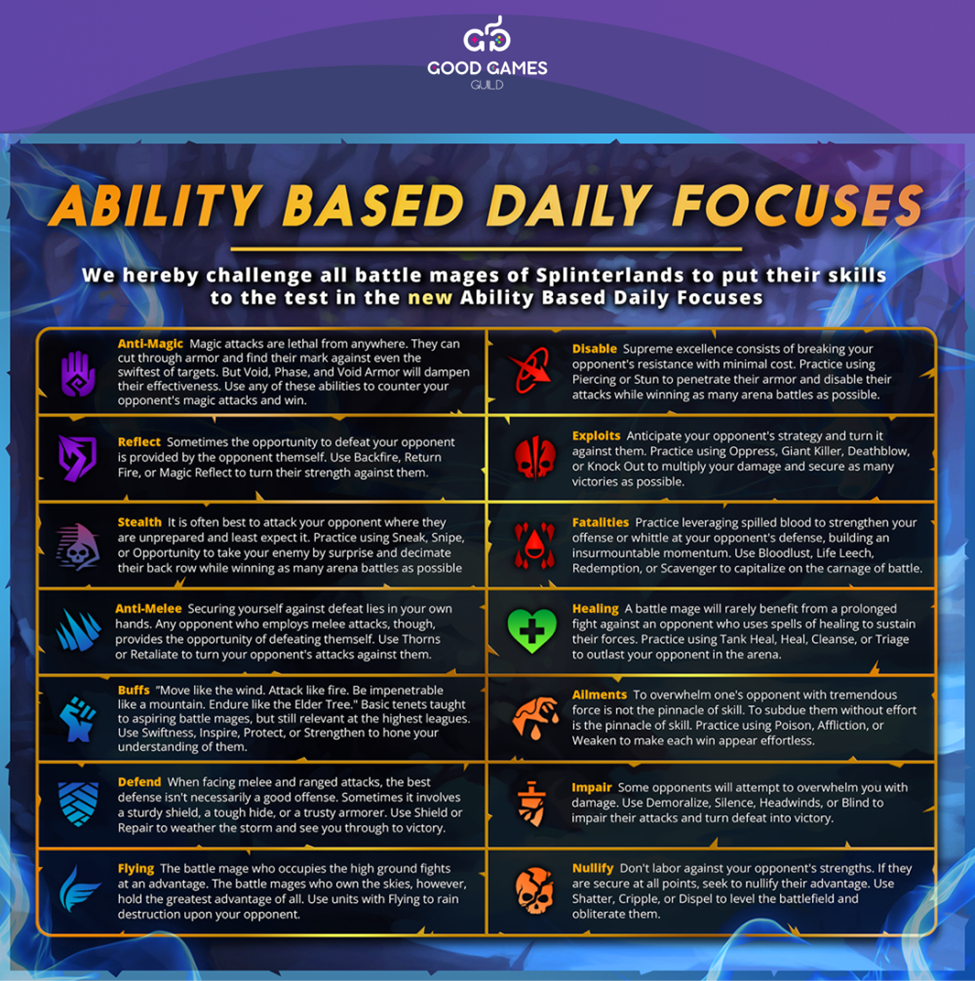
Not all of these ability-based focuses will be available in the lower leagues, due to fewer cards having certain abilities in lower leagues. Below is a summary of the Daily Focuses and the Leagues from which they will be playable in.
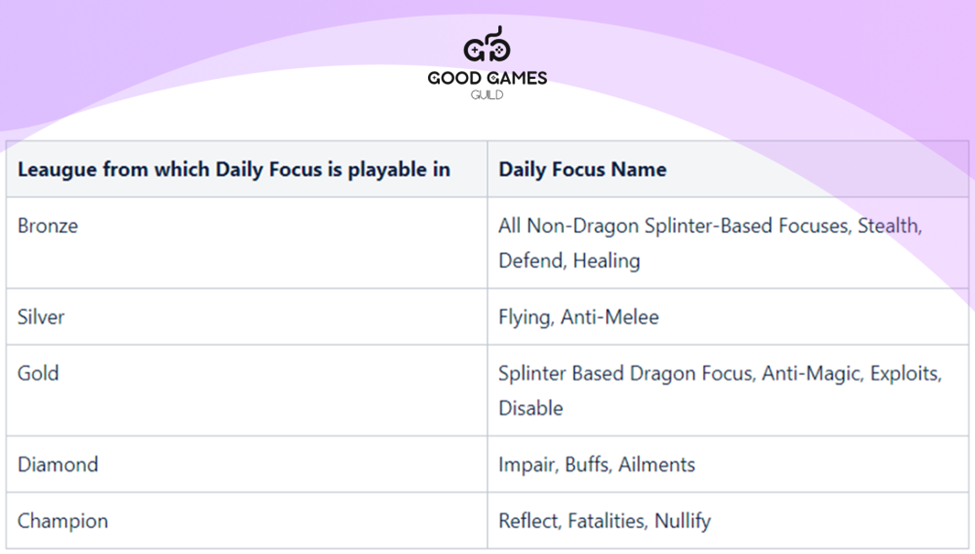
—Season Rewards
Splinterlands seasons have various lengths, usually ranging from 12-16 days. At the end of each season, rewards are distributed to players as both Loot Chests (for the League in which they end the season), and DEC (for the top players of each League). Modern and Wild formats make use of the same season, meaning that all the ranked battles won in either the Modern or Wild battle format will contribute towards the same season rating.
A player's placement at the beginning of the next season and the Loot Chests they are able to earn depend on the maximum league achieved in the previous season between the Modern & Wild formats. A maximum of 150 loot chests can be earned in a single season, and players in any league from Bronze to Champion have the opportunity to earn the maximum number of chests.
—Loot Chests
There are different loot chests (one for each league) earned for the season and daily focus rewards. Note that the Daily Focus chest tier is based on the current best league between the Modern & Wild formats at the time the Daily Focus is started, while the Season rewards chest tier is based on the maximum league achieved in the previous season between the Modern & Wild formats.
Each chest will have at least one item in it: Some SPS, Potion(s), a Chaos Legion pack, Merits, or a Reward Card. Higher-level chests will have either more SPS, Merits, Potions or better chances of higher valued rewards. The details of the rewards for each type of chest are shown in the table below:
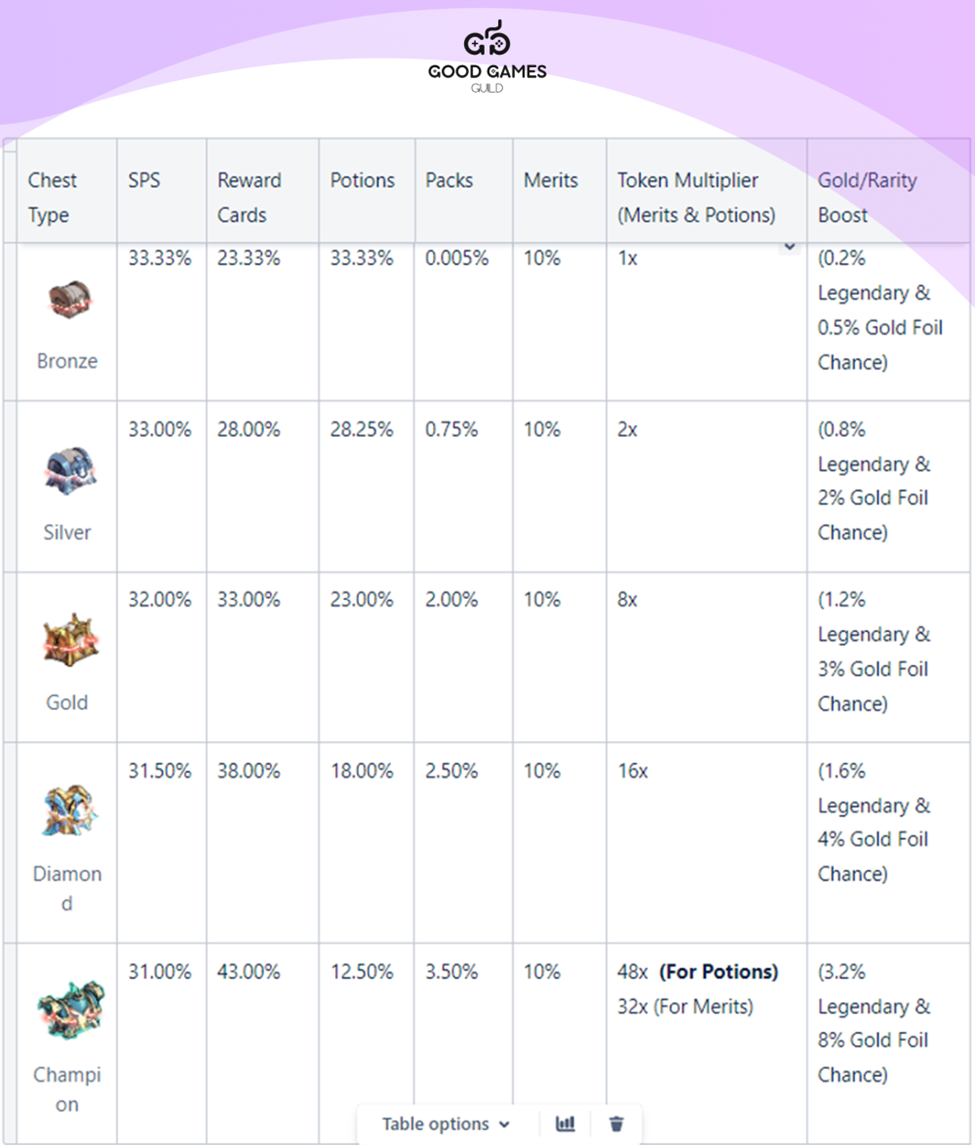
—Leaderboard Rewards
In addition to the End-of-Season chest rewards, there are also two separate leaderboards (One for Modern and one for Wild) that top players from each League can compete in. And the best part is that players will not have to choose to compete for a spot on one or the other Leaderboard; they can challenge the top players for their spot in both. This means that a player can get high up the leaderboards for each and get two season prizes as a result, one for Modern and one for Wild.
Each respective leaderboard is awarded a total of 3,622,000 DEC (Dark Energy Crystals) for the reward pool each season. The top finishers for the season, in both Modern & Wild leaderboards, from each of the 5 Leagues (Bronze, Silver, Gold, Diamond, and Champion) receive DEC for the position they achieve.
Bronze – 122,000 DEC are awarded to the top 20 in total, of which 30,000 DEC goes to the 1st place.
Silver – 220,000 DEC are awarded to the top 25 in total, of which 40,000 DEC goes to the 1st place.
Gold – 420,000 DEC are awarded to the top 30 in total, of which 60,000 DEC goes to the 1st place.
Diamond – 890,000 DEC are awarded to the top 40 in total, of which 100,000 DEC goes to the 1st place.
Champion – 1,970,000 DEC are awarded to the top 50 in total, of which 200,000 DEC goes to the 1st place.
NFTs
As a digital collectible trading card game (TCG), the key component of Splinterlands is its cards. These are Splinterlands card basics.
—Card Types
There are two types of cards:
• Summoners
A magic user who harnesses one of six primal forces. They use this power to summon monsters.
• Monsters
Any person or creature that is called forth by a Summoner to do battle. Monsters do the actual fighting.
Both Summoners and Monsters may be found in Splinterlands Booster Packs.
—Card Stats
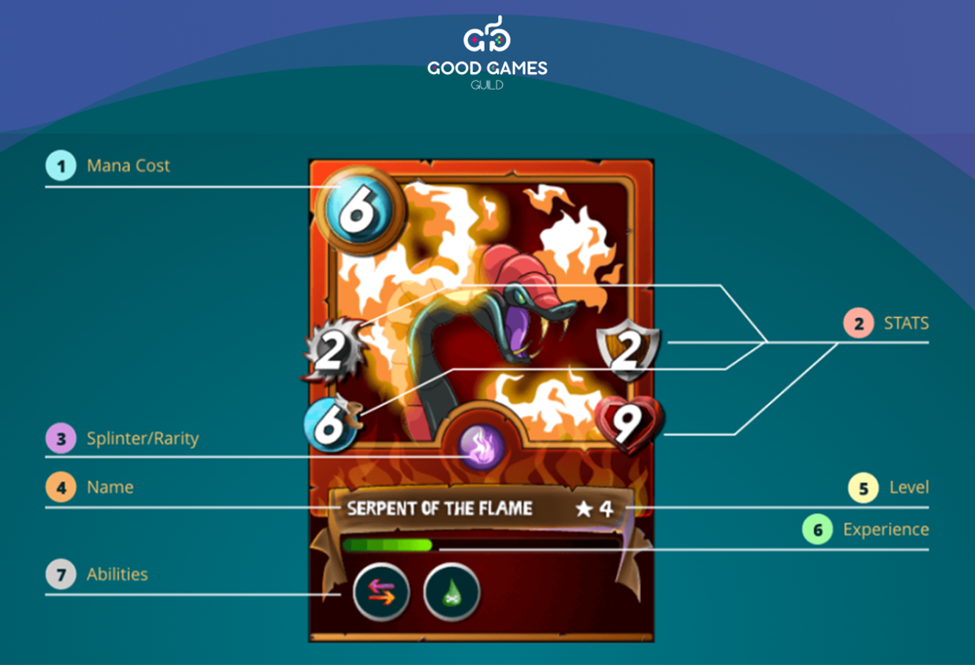
STATS are the core attributes of the character. If the character can Attack (most of them do), it will display one of the following three Attack forms:
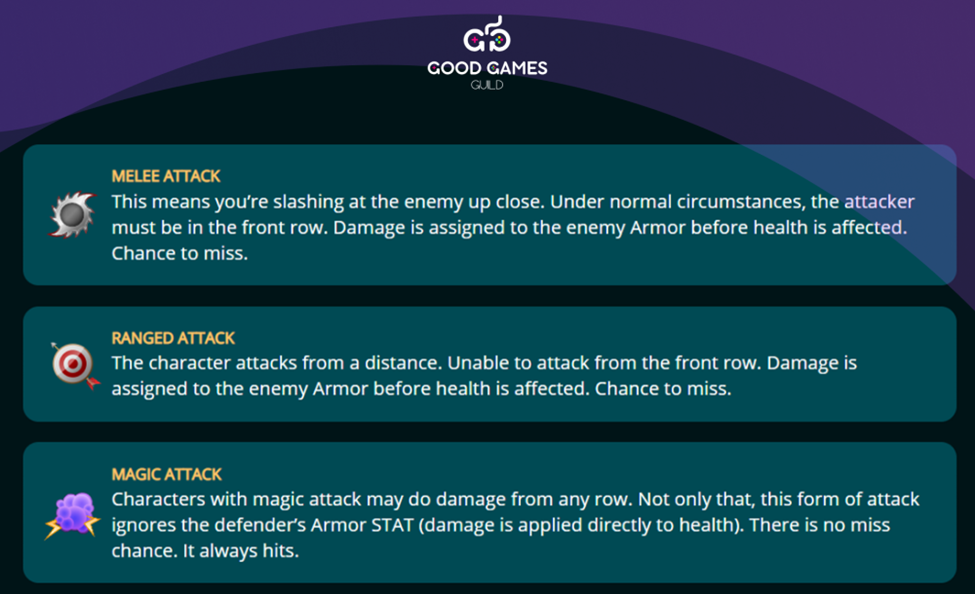
Besides Attack, they also have other STATS, namely:
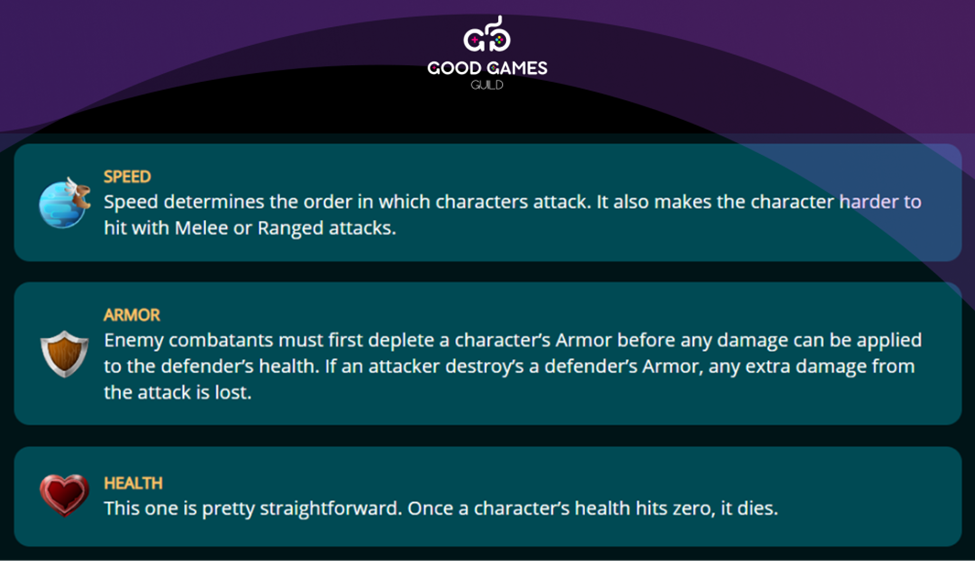
If you ever want to review how a character’s STATS will change as it levels up, simply head over to Your Collection. Click on the character, then select the second tab labeled “STATS”. This will display a chart that shows you all the STAT increases and Ability unlocks for each level.
—Card Rarities
Card Rarities determine how likely a certain card is to be found in a Booster Pack or Loot Chest. The rarity, along with the set, determines how many copies need to be combined to level up a card to reach its Maximum Potential.
Legendary cards are the rarest in Splinterlands, with the lowest total supply per card. In Booster Packs, the normal chance of revealing a Legendary is 0.8%, but this chance can be doubled to 1.6% by using a Legendary Potion charge.
Epic cards are the second rarest type of card in Splinterlands. In Booster Packs, the chance of revealing an Epic card is 4.8%. The 4.8% chance is the same whenever a card is found inside a Loot Chest.
Rare cards are rimmed with blue before being revealed. At least one card that is Rare or better is guaranteed in every Booster Pack. The chance is revealing a Rare card when opening Booster Packs and card-containing Loot Chests is 24.8%.
Common cards are found 69.6% of the time when a card is revealed in a Booster Pack (or 68.8% with Legendary potions).
—Combining Cards
In Splinterlands, cards are only leveled up by combining like cards. Combining cards is permanent, and there is no in-game benefit to combining until the next level has been reached.
—Booster Packs
The main product sold by Splinterlands is “Main edition” booster packs. Booster packs from the currently active set (Chaos Legion), as well mini sets (Riftwatchers - GEMS) can be purchased in the Splinterlands shop or on various third-party platforms.
—Set/Editions
• Alpha
The Alpha set was the first set that was ever sold, beginning with Splinterlands' launch in May 2018. 300,000 Alpha booster packs were created. It was also the only set whose summoners and monsters were reused (in the Beta set) because of the initial low supply of the first Alpha cards.
Today, players earn a 10% RShares bonus for each Alpha card used in battle. Alpha Booster packs have become exceedingly rare, but they can still sometimes be found on secondary markets like HIVE-Engine or Atomic Hub.
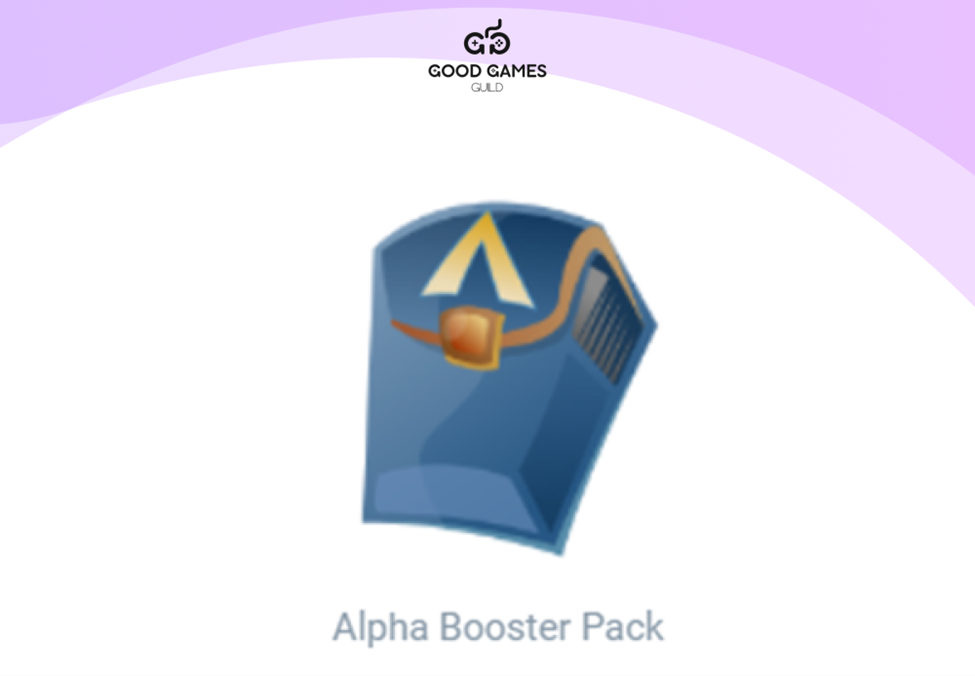
• Beta
Beta Booster packs were the first large sale of Splinterlands packs, with nearly 1 million total packs sold. Beta versions of all the same summoners and monsters from the Alpha set were used, plus the addition of Neutral (Splinter-less) cards, and new Epic and Legendary summoners.
Today, players earn an RShares bonus of 5% for each Beta card used in battle. Beta Booster packs have become quite rare, but they can still sometimes be found on secondary markets like HIVE-Engine or Atomic Hub.
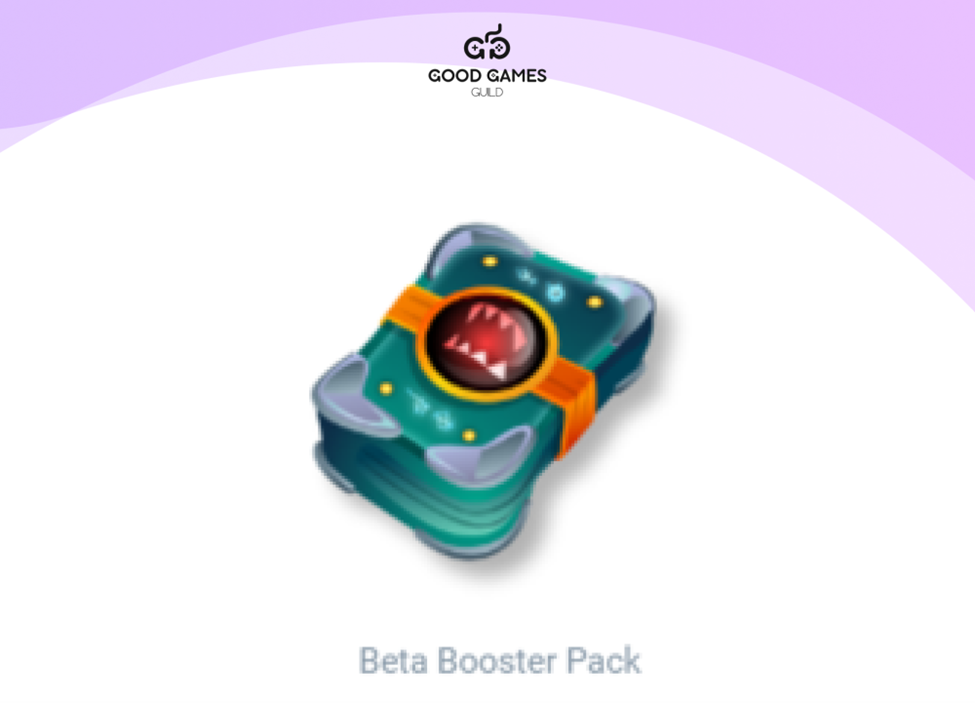
• Untamed
Splinterlands Untamed was a set of 71 brand new cards (monsters and summoners) that began sales following the sellout of the Beta Set. During this set, an additional purchase reward system of airdrops was also implemented. These airdrops took place every 100,000 packs sold with the release of a brand new card, and players had a greater chance of receiving the new card based on how many Untamed packs they had purchased from Splinterlands.com.
The Untamed card edition boasted many new abilities which were not previously found on the cards of the Alpha or Beta sets. The Untamed Booster packs are currently sold out however packs and cards from this edition can still be purchased in the Splinterlands Card Market or various other third-party markets.
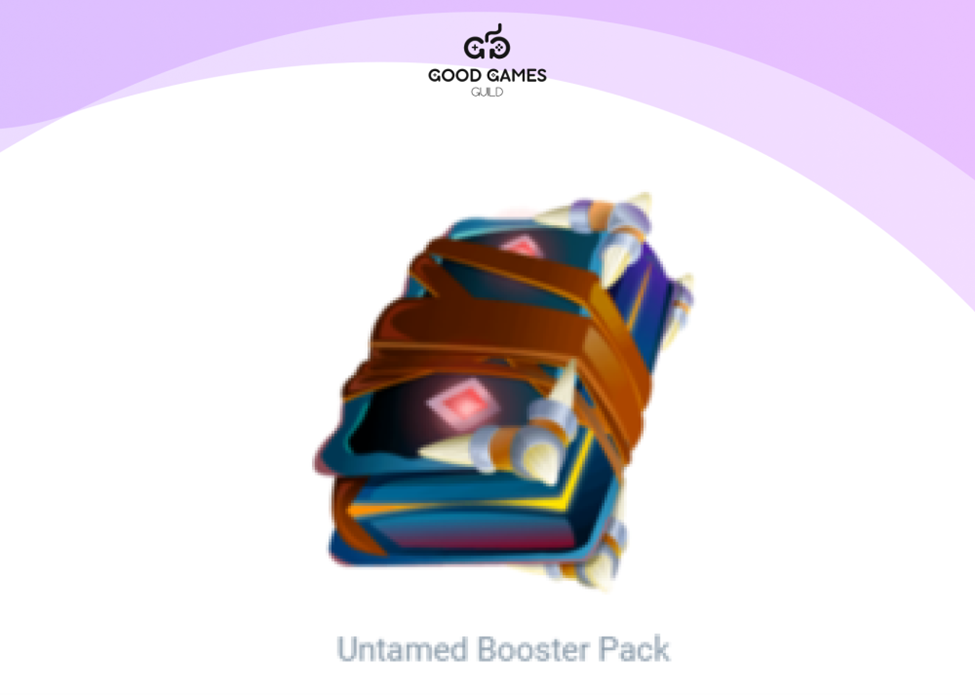
• Essence Orb & Promo Cards
The Essence Orb promotional set consists of 25 cards of various origins. The entire 12-card this set was released under the Promo category and another 13 cards in the set come from various promotional special releases like the Halfling Alchemist, which was created in celebration of the BTC halving of 2020, and such Mystery Potion Reward cards as Archmage Arius, Prince Julian, the Mighty Dricken and Waka Splinterblade.
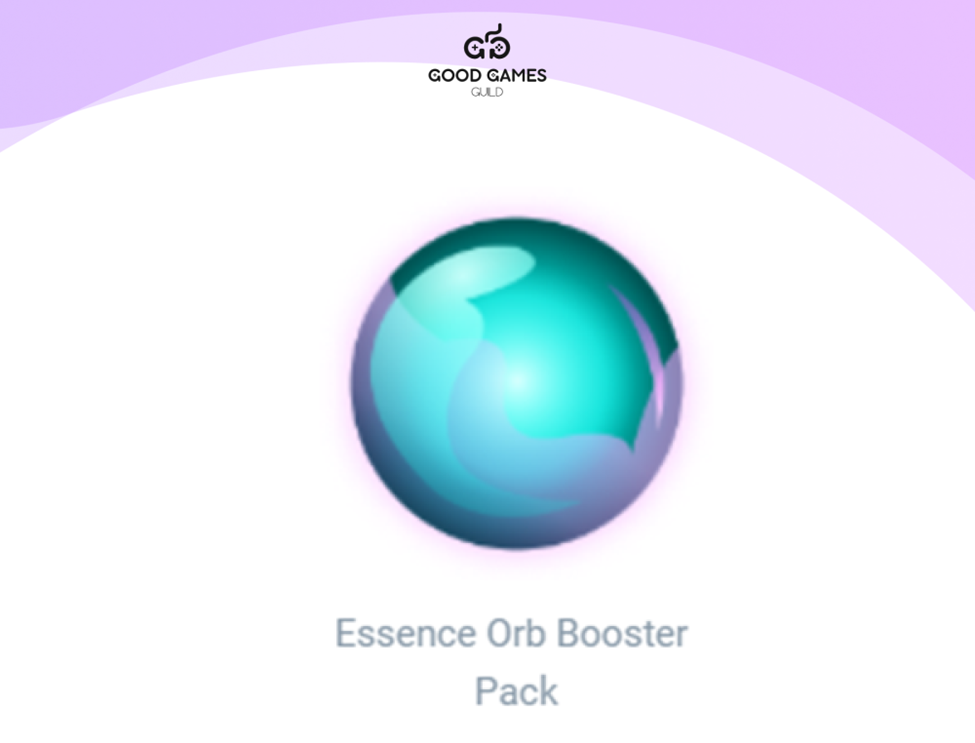
• ΛZMΛRÉ Dice
This set consisted originally of 20 unique cards plus an additional 5 cards that were released using the same airdrop method (per 50,000 packs sold) as Untamed. The more ΛZMΛRÉ Dice packs a player has purchased, the greater their chance of receiving each airdrop card. The ΛZMΛRÉ Dice sets are currently sold out however cards from this edition can still be purchased in the Splinterlands Card Market or various other third-party markets.

• Chaos Legion
The Chaos Legion Set was released on October 18, 2021. The Chaos Legion card set is the third major card expansion to be introduced into the Splinterlands game. 15 000 000 Chaos Legion booster packs were created.
With over 100 new cards bursting with eye-popping artwork and strategy-changing abilities, it represents Splinterlands’ largest and most ambitious release to date. Chaos Legion packs are currently being sold at Splinterlands.

• Riftwatchers
Splinterlands Riftwatchers is a set of 43 brand new cards (13 common, 12 rare, 6 epic (Summoners), and 12 legendary (including 5 airdrops, in addition to the limited edition promo card)). 3 million Riftwatchers Booster Packs were created. Similar to previous editions, Riftwatchers contains 5 cards that will be added to the set each time 500k Riftwatchers packs are sold. These cards will also be airdropped to players who have already purchased Riftwatchers packs, with each pack having a chance of receiving an airdropped card. These cards will each be Legendary rarity, and there will be one for each of the five basic elements in the game. 100% of the SPS tokens spent on purchasing Riftwatchers mini sets go directly to the SPS DAO for the benefit of all token holders.
The Riftwatchers card edition introduces the new Fury ability to the Splinterlands battlefield.

• Reward Edition Cards
Reward cards can only be found in Loot Chests earned from Ranked play. They behave the same as all other Splinterlands cards in that they can be combined, burned, transferred, or bought and sold on the secondary market.
There are 33 different Reward cards currently being released in Loot Chests. These reward cards are made up of four Dragon cards, five cards from each (Life, Death, Water, Earth, Fire) Splinter element as well as four Neutral cards. The breakdown of the rarity for these cards is 10 Common, 11 Rare, 6 Epic, and 6 Legendary cards.
—Gold Foil Cards
All cards are available in a much more scarce Gold Foil variation that offers bonuses when playing and for which fewer cards are required to level up.
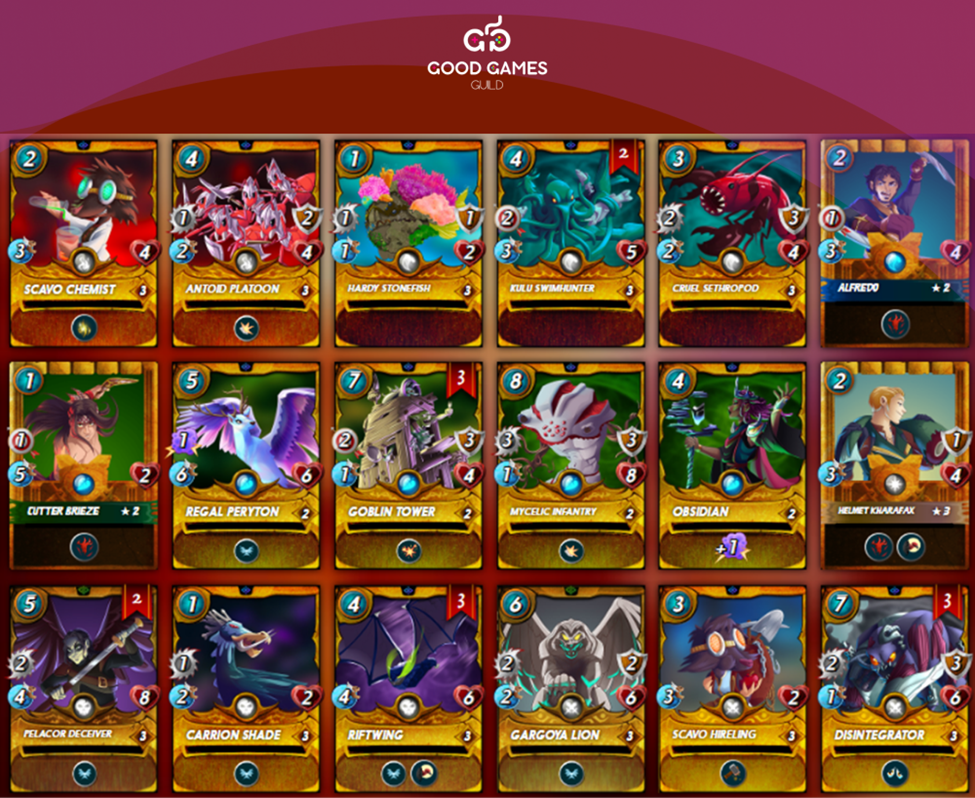
When opening packs, every card has a 2% chance of turning gold just after being revealed. Using an Alchemy Potion when opening packs will double your chances (4%) of a card turning gold.
When played in Ranked battles, each Gold Foil card earns the player a 10% RShares bonus upon their victory. This bonus can be stacked, meaning that it can be used on up to 7 cards per battle (1 Summoner and 6 Monsters). So the maximum bonus that can be earned in Ranked battles by using Gold Foil cards is 70% more RShares per win.
Additional Feature

—Rentals & Delegations
Splinterlands on-site card rentals, launched in mid-2021, allow players to rent or lend cards directly through the Splinterlands.com collection interface daily. Rentals are broken down into a DEC per day price, allowing players to rent for as little as two days if they like. Rental fees are automatically transferred each day as DEC.
If either party cancels a rental within the first day, it will not end until 2 days have passed since the rental started. After the minimum 2 days have passed, then rentals will continue daily for payments, cancellations, and extensions.
Cards can be easily delegated (Loaned) to another Splinterlands account through the Card Collection page. Delegation is the tool that makes card rentals possible through smart contracts.
—PeakMonsters
PeakMonsters is a third-party Splinterlands explorer, market, and interface that was created in the earliest days of Splinterlands. Peakmonsters allows additional market features such as Bids, Rentals, SPS Dashboard, All Market Activities, Pack Openings, Season Rewards, Combining of Cards, and Market History Page.
You can log in to PeakMonsters with your Splinterlands account (which is also a Hive account).
—Guilds
Splinterlands Guilds fight together, grow together, and use their combined resources to earn additional value, including DEC bonuses and discounts on various Splinterlands purchases.
• Building
o Guild Hall
The Guild Hall determines the main limitations of your Guild. The level of your Guild's Hall determines the max level of every other building in your Guild. Higher levels of Guild Halls require DEC contributions but allow your Guild to contain more members.
o Quest Lodge
The Guild's Quest Lodge determines the number of bonuses and discounts that can be taken advantage of by members of the Guild.
Two main benefits grow based on the level of your Guild's Quest Lodge:
DEC Bonus - This is a bonus each Guild member receives for DEC earned with every ranked battle win.
Shop Discount - Guild members receive a discount on some items (such as Potions & Skins) purchased with DEC.
o Arena
Guild Arenas are constructed to host huge battles (known as Brawls). The larger the Arena, the bigger the Brawls. A Guild's Arena level determines the level of Brawl they will be able to play, as well as the amount of participating players and rewards that can be earned. For performing well in Brawls, guilds will be rewarded with CROWNS. These are special, non-transferable, non-tradeable guild currency that will allow the guild to upgrade the arena and other buildings as well as purchase items for the guild in the guild shop.
o Guild Store
The higher your store level, the greater your bonus for merits gained from brawl participation, (to receive merits at all, the store must be at least level 1)
Merit bonuses - The higher the Store level, the more Merits you will win as rewards for Brawl participation. These Merit bonuses will also apply to Merits earned from the daily and season reward chests. To be eligible to receive Merits, your guild must have at least a level 1 Store, so constructing this building right away should be a priority.
Store items - Reaching certain levels will unlock new items, which will then be purchasable in the Store. Guilds should strive to reach Store level 2 as quickly as possible, as that unlocks Gladius Cases for purchase.
o Barracks
• Brawls
Brawls are Guild vs Guild arena combat, similar to Anytime tournaments, but with several guilds all facing off against each other and more emphasis on teamwork with your guild mates rather than rewarding individual performance. There are two types of Brawl rewards: guilds themselves win Crowns, and the individuals within the guild win Merits.
Not all Guilds fight in the same brawl. There can be many Brawls ongoing simultaneously. Up to 10 guilds of the same Tier are randomly grouped together for each Brawl. Brawl Tiers can range from 1 star to 5 stars. Guilds that are in the same Tier will be matched against each other. Higher Tiers generally mean more guild members can participate at once. All brawls are fought in the Wild battle format, meaning that brawls allow the use of all cards from all editions.
• Crowns
Crowns are the cooperative Guild currency that is earned for victories in Brawls. Higher the Arena level and Player participation, the higher the number of Crowns that a guild stands to win. Crowns that are awarded to the guild can be used by Guild leaders and co-leaders to upgrade the Guild Arena, Guild Barracks, and Guild Store once the cumulative DEC requirements on said buildings have been met. Crowns can also be used by Guild leaders and co-leaders to purchase selected items in the Guild Store that costs Crowns.
• Merits
Merits are a non-transferable guild currency used to buy items in the Guild Store. Everyone who participates in a Brawl will receive Merits when the Brawl ends. As Brawling is a team sport, every participant in a given guild who submits at least 75% of their battles will receive the same amount of merits, regardless of win/loss/draw record. However, these amounts will differ from guild to guild.
Tokenomic

DEC & SPS are essential tokens in the Splinterlands economy.
DEC or Dark Energy Crystals is one of the main in-game currencies of Splinterlands. DEC is used to purchase or rent cards in the game and can be traded or bought through a variety of engines including Hive, Steem, Tribaldex, and more. You may also stake your DEC through liquidity pools to earn SPS and DEC rewards.
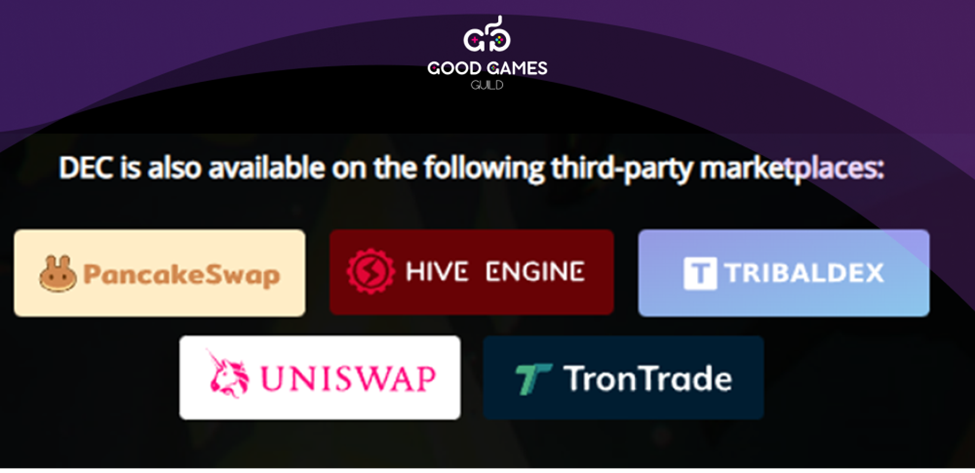
DEC can be traded, transferred from wallets like Metamask or Hive, or swapped among players in the game or through third-party sites. DEC can also be purchased with a FIAT currency. This method is available on the Splinterlands website and can be used to purchase HIVE with a credit card or bank transfer, which will be automatically converted to DEC.
SPS or Splintershards is a cryptocurrency and the official governance token for Splinterlands. Holding, adding liquidity to pools, and staking SPS comes with a variety of rewards and promotions. Staking SPS allows for voter power on proposals with 1 staked SPS per vote.
The SPS token is set up as a DAO, also known as a decentralized autonomous organization, through smart contracts published on the Binance (BSC) platform. You can purchase or transfer SPS in and out from Splinterlands by utilizing Metamask, Hive, or other BSC-compatible wallets.
You can earn SPS through ranked battles in the Modern and Wild format. Keep in mind that the energy capture rate (ECR) and other variables will alter the amount of SPS earned per battle. The amount awarded per league per season is as follows:

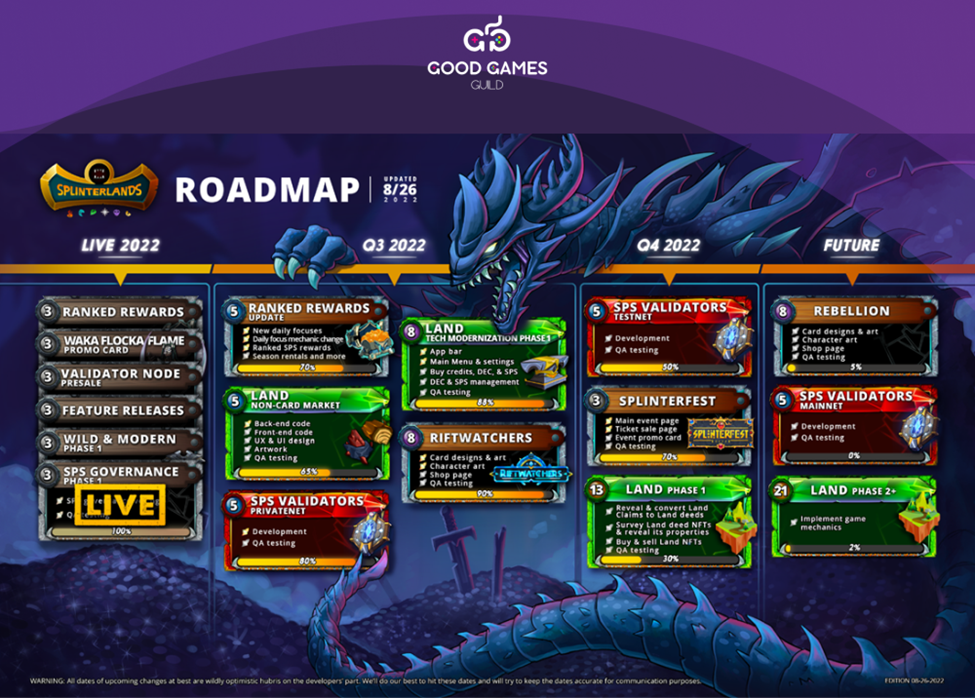
Roadmap

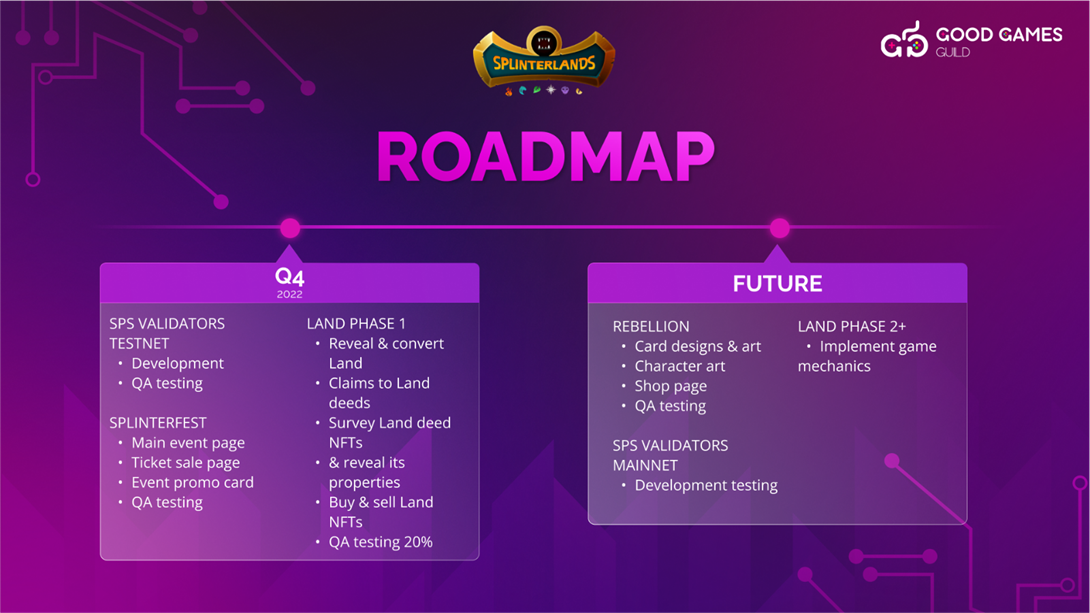
Teams
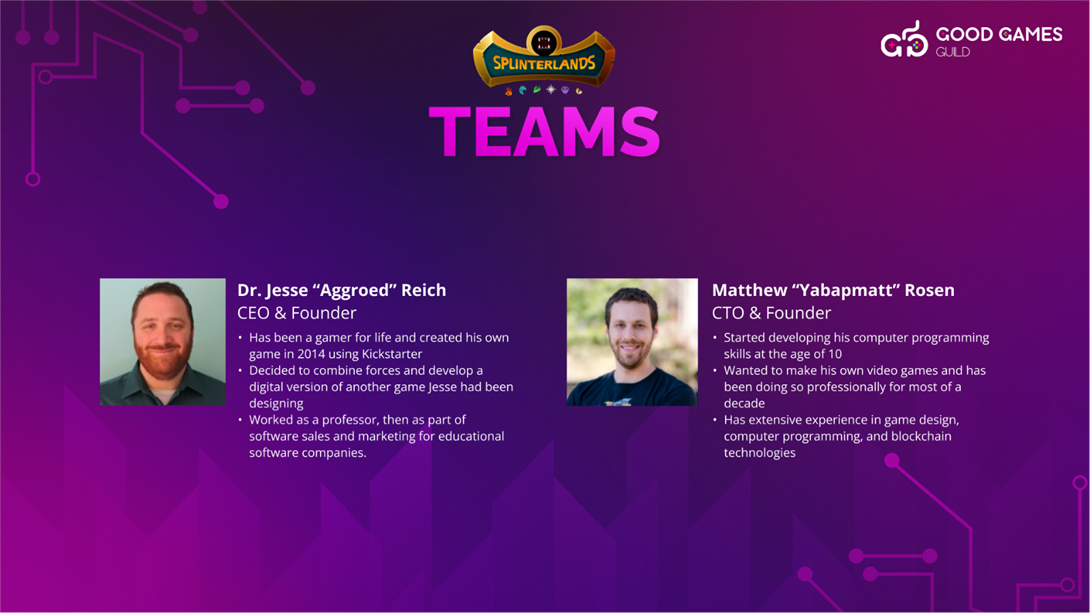
Dr. Jesse “Aggroed” Reich
CEO And Founder, Jesse has been a gamer for life and created his own game in 2014 using Kickstarter. After working with his partner Matt, they decided to combine forces and develop a digital version of another game Jesse had been designing. Before founding Splinterlands, he worked as a professor, then as part of software sales and marketing for educational software companies.
Matthew “Yabapmatt” Rosen
CTO And Founder, Matthew started developing his computer programming skills at the age of 10. He wanted to make his own video games and has been doing so professionally for most of a decade. He has extensive experience in game design, computer programming, and blockchain technologies.
Community
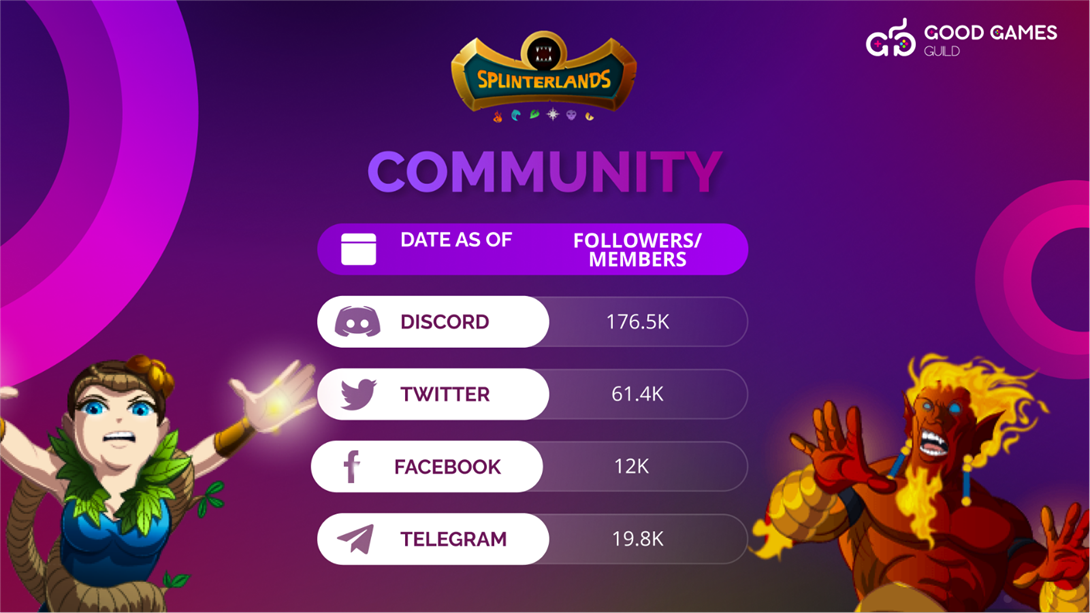
At the time of writing, Splinterlands has 61.4K followers on Twitter, 176.5K members on Discord, 19.8K members on Telegram, and 12K followers on Facebook. The team responds quite quickly on Discord and Telegram to questions and problems raised by the community.
Splinterlands has the typical Discord channel discussions around gameplay, announcement, tech updates, tutorial videos, guides, lore, trivia, strategy, tournaments, tokenomics, support, and dao discussion. Members from non-English countries are also accepted and given their respective channels for an international chat. In addition, there are community-sharing channels for memes, art leaks, and video streams.
Furthermore, Splinterlands have a public calendar for Public Events hosted by Splinterlands. On top of that, Splinterlands have a central hub for community networking hosted by Splinterlands on Inverse every two months. The hub is named DYGYCON and is a metaverse convention organized by Splinterlands that features crypto projects, presentations, giveaways, and blockchain projects you should keep an eye out for. Every DYGYCON comes with some awesome SWAG from the sponsors.
Other than this, the team has weekly updates about release notes on the whitepaper (https://docs.splinterlands.com/platform/release-notes). Also, Splinterlands have its media platform designed to be a wiki (https://splinterlands.fandom.com/wiki/Splinterlands_Wiki) that fans can explore and contribute to.
| Website | Twitter | Blog | Discord | Telegram | Facebook | Reddit |
Latest Articles